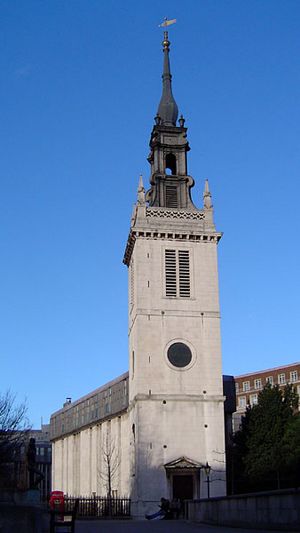St Augustine Watling Street facts for kids
Quick facts for kids St Augustine, Watling Street |
|
|---|---|

Photo of the site in 2004
|
|
| Location | London |
| Country | United Kingdom |
| Denomination | Anglican |
| Architecture | |
| Demolished | 1941 |
St Augustine, Watling Street was an Anglican church in the City of London. It stood very close to St Paul's Cathedral. This church was first mentioned in the 1100s.
Sadly, the original church was destroyed by the Great Fire of London in 1666. A famous architect named Christopher Wren then designed a new building. However, this second church was also destroyed by bombs during the Second World War. Today, what's left of the church is part of St Paul's Cathedral Choir School.
Contents
The Story of St Augustine's Church
Early Days of the Medieval Church
The church was located on the north side of Watling Street, near Old Change. It was named after St Augustine of Canterbury. The first time the church was written about was in 1148.
In 1252–3, a person named Alexander le Cordwaner gave land to make the church bigger. John Stow, who wrote in the late 1500s, called St Augustine's "a fair church." He also said it had been "lately well repaired." The church was partly rebuilt and made "richly and very worthily beautified" in 1630–1. This cost the local people about £1,200.
In 1965, during some work, the old foundations of the northern part of the medieval church were found. These old parts showed that the church from the 1100s was about 61 feet (18.6 meters) long. The part added in the 1200s was about 59 feet (18 meters) long and 16 feet (4.9 meters) wide.
This old church building was completely destroyed in the Great Fire of London in 1666.
Rising from the Ashes: Wren's New Church
After the huge fire, St Augustine's church joined with the parish of St Faith's. People from St Faith's used to worship in the basement of St Paul's Cathedral.
The new St Augustine's church was designed by the famous architect Christopher Wren. Its foundations, found in 1965, were made mostly from old stones that were used again. The new church opened in September 1683. However, its tall steeple was not finished until 1695.
The inside of the new church was about 51 feet (15.5 meters) long. It was also about 45 feet (13.7 meters) wide and 30 feet (9.1 meters) high. The main part of the church, called the nave, was separated from the side areas by arches. These arches were supported by special Corinthian columns.
The ceilings of the nave and side areas were curved, like a barrel. The nave ceiling had three skylights on each side to let in light. There were also balconies, called galleries, on the north side and at the back. The back gallery was later removed when the organ was moved to the south side.
The walls were originally covered with wood panels up to 8 feet (2.4 meters) high. This height was later lowered. The decorative screen behind the altar, called the reredos, also had Corinthian columns. The pulpit, where sermons were given, was made of carved oak. It was updated in 1878 by Arthur Blomfield.
Some important people served as rectors (head priests) of this church. These included John Douglas, who later became a bishop, from 1764 to 1787. Also, Richard Harris Barham, who wrote the Ingoldsby Legends, was rector from 1842 until he passed away in 1845.
The Church's Final Days
The church building was destroyed by bombing in 1941 during the Second World War. It was not rebuilt. However, its tower was repaired in 1954. This tower was later included in a new choir school for St Paul's Cathedral, which was finished in 1967.
The remaining parts of the church were given a special protection status, called Grade I listed building, on January 4, 1950.
Faith, the Church Cat
The church had a cat named Faith, who became quite famous after the air raid that destroyed St Augustine's. Days before the bombing, Faith was seen moving her kitten, Panda, to a safe spot in a basement. Even when people brought her back, Faith kept taking Panda to her chosen hiding place.
On the morning after the air raid, the rector searched through the dangerous ruins for the missing animals. He eventually found Faith, surrounded by smoking rubble and debris. She was still guarding her kitten in the spot she had picked out three days earlier.
The amazing story of Faith's warning and rescue reached Maria Dickin. She was the person who started the People's Dispensary for Sick Animals. For her bravery and care, Faith was given a special silver medal. When Faith died in 1948, her story was reported in newspapers all over the world.
See also

